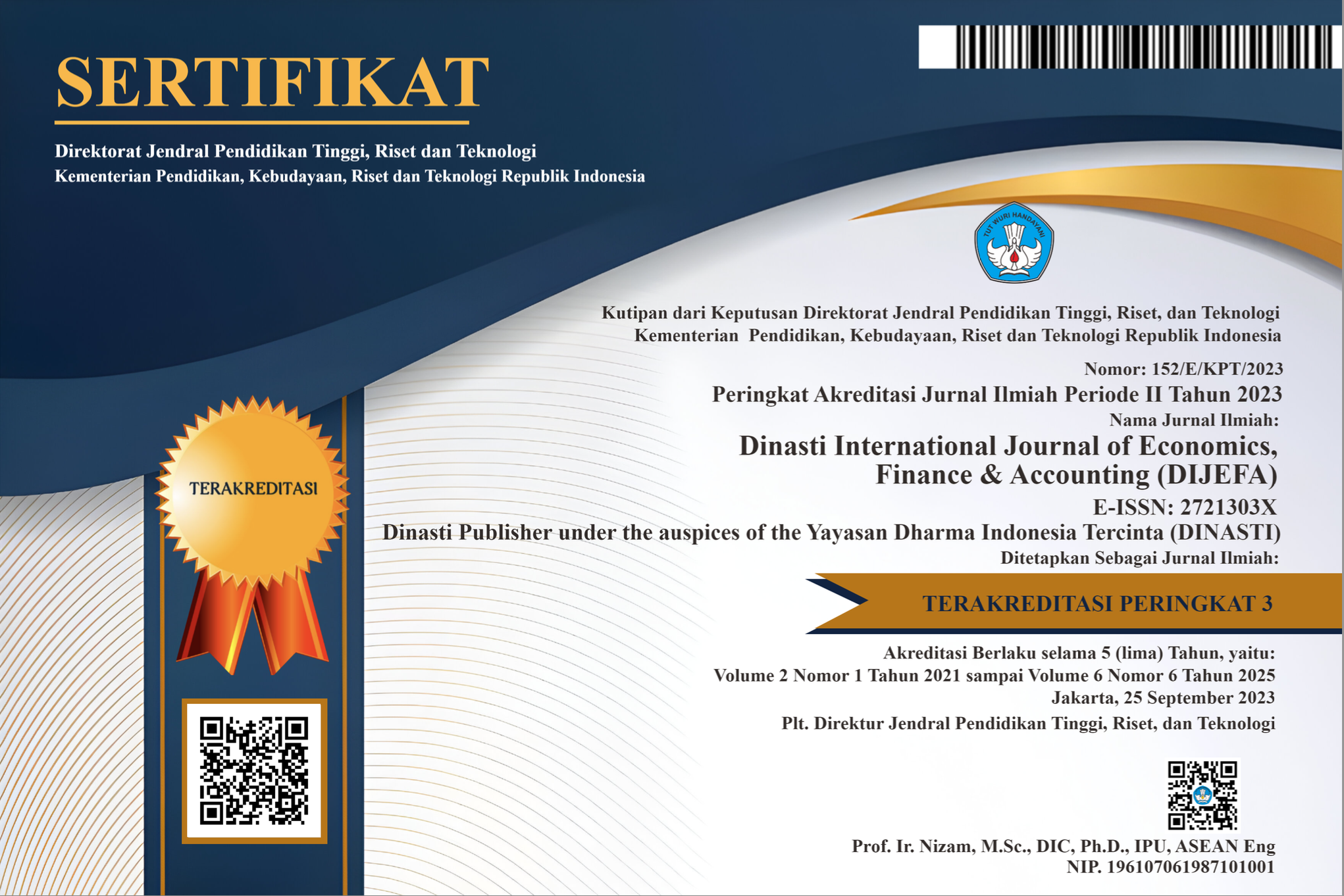Measuring Financial Sustainability: The Influence of ROA, BOPO, and NIM on Foreign Exchange National Private Commercial Banks in Indonesia
DOI:
https://doi.org/10.38035/dijefa.v5i4.3007Keywords:
Financial Sustainability Ratio, Return on Assets, Operational Costs to Operational Income, Net Interest Margin (NIM)Abstract
This research aims to analyze the influenceReturn on Assets(ROA), Operating Costs to Operating Income (BOPO) andNet Interest Margin(NIM) againstFinancial Sustainability Ratio(FSR) at National Private Commercial Banks for Foreign Exchange in Indonesia during the period 2018 to 2022. The population in this research is all National Private Commercial Banks for Foreign Exchange in Indonesia during the period 2018 to 2022. The sample selection technique used purposive sampling and 15 banks were selected as research data. . The data analysis method used is panel data regression analysis using Eviews 10. The research results show that: Return on Assets (ROA) has a positive and significant effect on the Financial Sustainability Ratio (FSR). Operational Costs on Operating Income (BOPO) and Net Interest Margin (NIM) have a negative and significant effect on the Financial Sustainability Ratio (FSR). The R Square value is 0.957730, indicating that the Financial Sustainability Ratio (FSR) is influenced by Return on Assets (ROA), Operational Costs to Operating Income (BOPO) and Net Interest Margin (NIM) of 95.77%.
References
Alim, M., & Sina, DI (2020). The Influence of Capital Adequacy Ratio, Non-Performing Financing and Net Profit on the Financial Sustainability Ratio (In Sharia Banking Companies in Indonesia for the 2014-2018 Period). Balance Vocational Accounting Journal, 4(1), 28-42.
Dangnga, MT, & Haeruddin, MM (2019). Banking Financial Performance: Efforts to create a healthy Banking System. Science Park Library.
Maruta, H. (2018). Du Pont model financial statement analysis as an integrative analysis. JAS (Journal of Sharia Accounting), 2(2), 203-227.
Nurhikmah, S., & Rahim, R. (2021). The Influence of Financial and Non-Financial Factors on Banking Financial Sustainability Ratios. Journal of Management and Business Review, 18(1), 25-47.
Putri, E., & Herfina, M. (2024). Perhitungan PPh Pasal 21 atas Gaji Pegawai Pada Kantor Wali Nagari Gurun Panjang Selatan di Kabupaten Pesisir Selatan. Jurnal Riset Akuntansi, Perpajakan Dan Auditing, 2(1), 27-32. https://doi.org/10.62194/j603e111
Wibowo, IAA, Wiyono, G., & Rinofah, R. (2020). The Influence of Liquidity Risk, Net Interest Margin, and Good Corporate Governance on the Financial Performance of Commercial Banks. Mode, 32(1), 53-65.
Yuliawati, Y., Jensen, L., & Saputri, PS (2020). Analysis of Factors Affecting the Financial Sustainability Ratio of Sharia Banking in Indonesia for the 2010-2016 Period. AL-IQTISHADY: Journal of Sharia Economics, 1(2), 132-140.
Downloads
Published
How to Cite
Issue
Section
License
Copyright (c) 2024 Muhammad Abdul Muis, M. Nurdin

This work is licensed under a Creative Commons Attribution 4.0 International License.
Authors who publish their manuscripts in this journal agree to the following conditions:
- The copyright on each article belongs to the author(s).
- The author acknowledges that the Dinasti International Journal of Economics, Finance & Accounting (DIJEFA) has the right to be the first to publish with a Creative Commons Attribution 4.0 International license (Attribution 4.0 International (CC BY 4.0).
- Authors can submit articles separately, arrange for the non-exclusive distribution of manuscripts that have been published in this journal into other versions (e.g., sent to the author's institutional repository, publication into books, etc.), by acknowledging that the manuscript has been published for the first time in the Dinasti International Journal of Economics, Finance & Accounting (DIJEFA).


























































